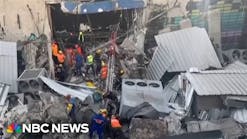There is a common belief that the decisions made within the first five minutes will dictate how the next 24 hours will go at the scene of any emergency. Some emergencies can be considerably overwhelming to first responders, and quickly overcome the capabilities of local emergency crews. This is especially true with significant events involving collapsed buildings and other urban search and rescue (USAR) responses.
As with any incident, time is of critical importance; it is imperative that the command staff identify the needs of the incident and begin to move necessary resources to the scene as soon as possible. For USAR teams, it is not as simple as calling the local dispatch center and “ordering” these resources. It takes time to go through the proper channels at the local, state and federal levels to get the authorization for deploying the team. But once the deployment is authorized, there will be a team of critical personnel deployed ahead of the USAR forces: the Incident Support Team (IST).
The IST is a fast-moving deployment team charged with providing advice, command support and assistance, logistical coordination and support, and direction for USAR operations at the incident scene. The Federal Emergency Management Agency (FEMA) has developed this resource to respond on a national level; however, many local rescue teams and state USAR teams have embraced this resource approach on a home-field jurisdictional level.
First on the scene
This team is made up of specialists who are highly experienced firefighters, rescuers, officers, physicians, engineers and law enforcement personnel who set the stage for and coordinate all task force operations. Mobilizing and deploying USAR resources for disaster response can be a formidable task (photo 1). Many of these teams provide a wide variety of technical rescue capabilities, including search, rescue, water rescue and medical capabilities. To maximize the speed and efficiency in which these resources are mobilized and used, the IST is sent to the scene first.
The initial IST can be comprised of up to 20 personnel, including positions such as:
• Team leaders
• Team commanders
• Safety officers
• Section chiefs
• Structures specialists
• Communications leaders
• Medical unit leaders
• Situation unit leaders
As the incident increases is size and complexity, or if duties and responsibilities of the team expand, it may become necessary to expand sections of the IST, in a similar fashion as the Incident Management System (IMS) can be broadened. These specialists can provide guidance and direction for state and local officials with technical assistance and advice, management and coordination of USAR resources, mitigation measures, support needs and logistical support.
As with every other position in the USAR world, there are requirements for the IST team members in regard to mobilization and performance standards:
• Be physically fit to perform in the disaster environment
• Basic life support (BLS) and CPR training
• Be aware of the signs of critical incident stress
• Be available to mobilize within two hours
• Be capable of functioning in hazardous and stressful situations for long periods under adverse conditions
• Maintain current inoculation status
• Trained in various task force functions, including USAR operations, strategy, tactics, and safety considerations, and general state/local emergency management structure
• Strong communications skills, both orally and written, using current communication systems
• Completed the FEMA IST course
On scene, the IST staff will meet with the command staff and determine the needs, complexity and the duration of the operation that would require USAR deployment (photo 2). There are some critical points that have to be addressed to determine the extent of the deployment, such as cause of the event; accountability/people unaccounted for; affected critical infrastructure; governmental property/responsibility; resources available in the area; and command staff and designation.
Once an assessment has been made of the situation and the needs of the incident, a memorandum of understanding (MOU) is customarily drawn up and submitted for approval by the local incident commander. It is a requirement that serves as assurance that there is a complete understanding by all parties involved of the actual scope, nature and requirements of the resources while operating at the incident. It serves as a delegation of authority that covers some critical points, such as:
• The duration of the deployment
• Operational assignments and expectations
• Who is involved in the agreement
• Means of logistical support
• Flow of information
• Briefings and meeting schedule
• Methods of contact for all involved parties
IST operations
Upon arrival of the USAR resources deployed to the incident, IST personnel will issue assignments that satisfy the needs of the incident. The coordination of these assignments is passed down to the IST Operations Section Chief, which are then assigned to specific task force leaders. The leaders are responsible for managing and supervising the task force elements from the time of activation throughout the demobilization process. The IST will continue to coordinate the activities of task forces and will coordinate the logistical support, re-supplying and demobilization of all of the task forces (photo 3).
The IST will also work through the after-action process, identifying any operational issues, specific problems that were faced and corrective action plans that were put in place during the incident. Many times, this is performed in a two-phase process; the first phase is usually done before the IST is released from the incident and provides a platform for the IST to identify concerns and issues that may need to be addressed. The second phase is more detailed and is usually done after all personnel have had time to rehabilitate themselves and will serve as the basis for the written after-action report.
The after-action report is a formal report developed from the incident that includes, at a minimum:
• An executive summary of the incident
• The overview of the mission
• Evaluation of the IST organization and deployment
• Any safety concerns during the incident
• Management or coordination issues between any of the responding resources
• Communications issues
• Shift scheduling and rotations
• Logistical issues
• Equipment and tool management
• Medical issues and injuries during the incident
• Tracking of resources and support equipment
• Performance of IST/command staff
This report is to be forwarded to the program officer within 30 days of the incident.
Conclusion
The dynamics of a significant incident will tax local resources beyond their capabilities – not only in tactical operations, but also in administrative control and resource management. Having assistance for managing large scale operations is paramount for safety and success, and an IST can prove beneficial in this arena. Know the resources that are available in your own jurisdiction and become familiar with their capabilities; getting introduced before the incident will pay dividends on the incident scene.
For more news and training on rescue and special operations, visit: http://www.firehouse.com/topics/rescue-special-ops.
MIKE DALEY is a lieutenant and training officer with Monroe Township, NJ, Fire District 3 and an instructor at the Middlesex County Fire Academy, responsible for Fire and Rescue Training Curriculum development. Daley also is a rescue officer with the New Jersey Task Force 1 – Urban Search and Rescue team. He holds certifications as Rescue Technician, Incident Safety Officer, Hazardous Materials Specialist and On-Scene Incident Commander, EMT, Level II Fire Instructor, SCBA/Smokehouse and Live Burn Instructor, Fire Inspector, and Fire Officer. Daley holds degrees in business management and public safety administration. He is the founder and senior consultant for Fire Service Performance Concepts. He may be contacted at [email protected].






